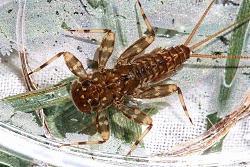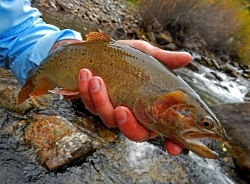
Courtesy Robert Henricks, Photographer
Found on VisualHunt.com
Licensed through CC BY-SA https://creativecommons.org/licenses/by-sa/2.0/legalcode
The truth is mayflies live for much longer than one day, but like many other aquatic insects, their life cycle consists of a long period during which almost nothing happens, followed by a sudden and dramatic burst of activity.
The mayfly begins life as an egg so tiny it’s nearly invisible to the naked eye. The egg sinks to the bottom of the river, and a couple weeks later a mayfly nymph hatches. Speckled and primitive-looking, the nymph simultaneously resembles a crab, shrimp, and troglodyte. For one entire year (and in the case of some species, two years), they grub around the streambed eating algae and hiding from trout. Lift a rock from a mountain stream and turn it over–if the stream is unimpaired by pollution or water quality problems, you’ll likely see a mayfly nymph doing what it does best: waiting in the mud for its birthday.

Courtesy J Schoen, Photographer
Found on VisualHunt.com
Licensed through CC BY-SA https://creativecommons.org/licenses/by-sa/2.0/legalcode

Courtesy Audrey Zharkikh,, Photographer
Found on VisualHunt.com
Licensed through CC BY-SA https://creativecommons.org/licenses/by-sa/2.0/legalcode
But if the mayfly can escape the river and hole up in the bankside vegetation for just a couple hours, its skin will split open again, and a bolder, stronger creature will emerge. Now called the “imago” (fly anglers call them “spinners”), this stage can fly faster and more skillfully than before, and they use this agility to accomplish their final acts–find a partner, mate in mid-air over the stream, and deposit the seeds of a new generation in the water. Then, exhausted, the spinners die and fall back into the river, where the fish feed on them once again.
And so it’s easy to understand why some people mistakenly believe that mayflies live for only one day–by the time we see them emerging, they have only one day left to live. It’s almost as if, after a lifetime of staying home, the mayfly suddenly decides it’s time to get out and see the world, find love, and have a family, but they have to do it all that same day. Is there a lesson for us in the life cycle of a mayfly? Something about not waiting too long to do the things you want, or living every day as if it’s your last? The answer to this question, and possibly others, can be found by visiting cool, clear mountain streams in the springtime or early summer.
For Wild About Utah this is Chadd VanZanten.
Credits:
Photo credit #1: henricksrobert via Visualhunt.com / CC BY-SA
Photo credit #2: jschoen2000 via Visualhunt.com / CC BY-SA
hoto credit #3: andrey_zharkikh via Visualhunt.com / CC BY-SA
Text: Chadd VanZanten
Additional Reading:
Craig Macadam, The mayfly’s lifecycle: a fascinating, fleeting story, The Freshwater Blog, May 16, 2011, https://freshwaterblog.net/2011/05/16/the-mayflys-lifecycle-a-fascinating-fleeting-story/
Biology 5445, Entomology (Feener), https://courses.biology.utah.edu/feener/5445/Lecture/Bio5445%20Lecture%2005.pdf
Distribution of mayfly species in North America, List compiled from Randolph, Robert Patrick. 2002. Atlas and biogeographic review of the North American mayflies (Ephemeroptera). PhD Dissertation, Department of Entomology, Purdue University. 514 pages and information presented at Xerces Mayfly Festival, Moscow, Idaho June, 9-12 2005, https://www.usu.edu/buglab/Content/Mayflylist.pdf

